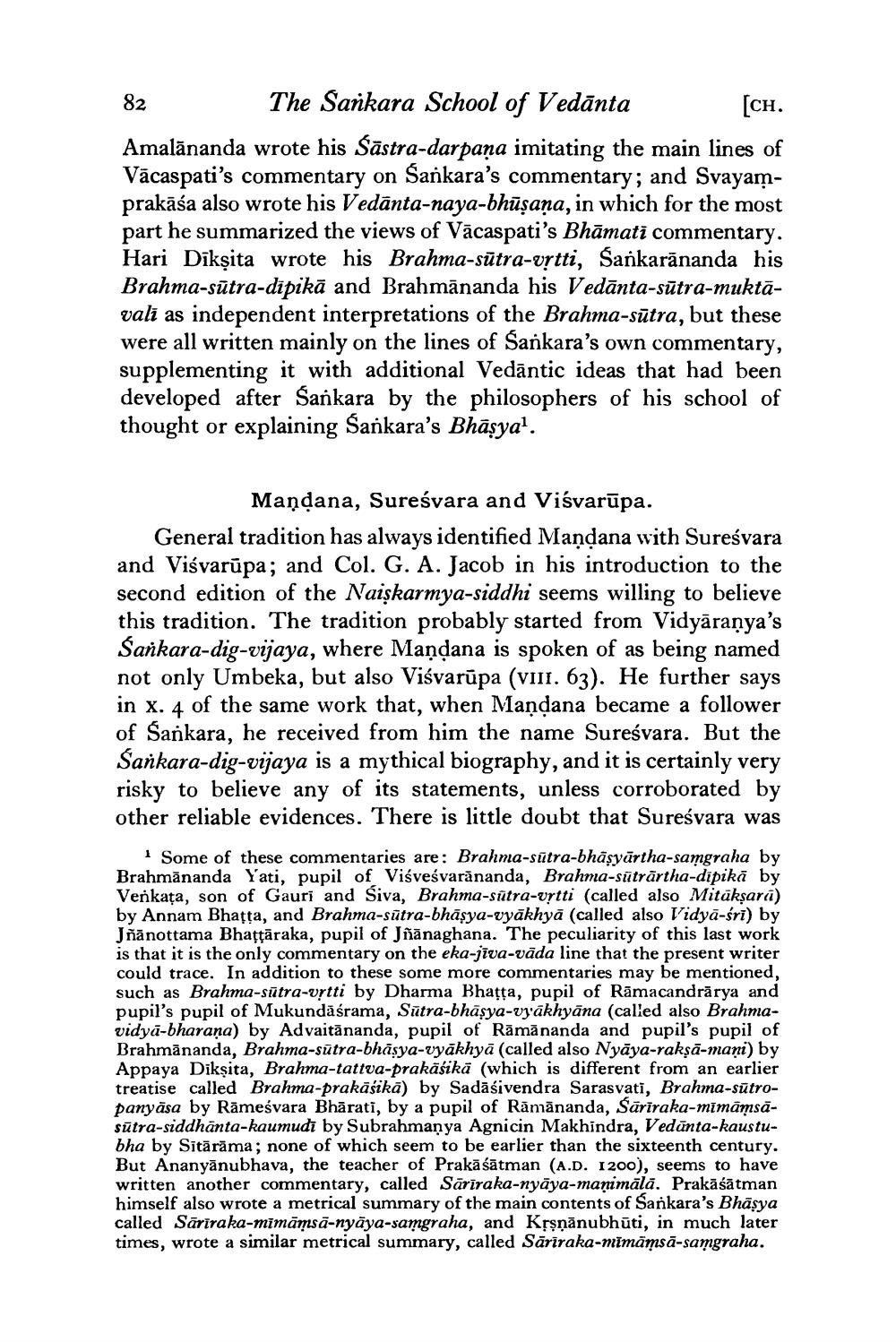________________
The Sankara School of Vedanta
[CH.
Amalānanda wrote his Šāstra-darpaṇa imitating the main lines of Vācaspati's commentary on Sankara's commentary; and Svayamprakāśa also wrote his Vedānta-naya-bhūṣaṇa, in which for the most part he summarized the views of Vacaspati's Bhāmati commentary. Hari Dikṣita wrote his Brahma-sutra-vṛtti, Sankarānanda his Brahma-sutra-dipikā and Brahmananda his Vedānta-sūtra-muktāvali as independent interpretations of the Brahma-sutra, but these were all written mainly on the lines of Sankara's own commentary, supplementing it with additional Vedantic ideas that had been developed after Sankara by the philosophers of his school of thought or explaining Sankara's Bhāṣya1.
82
Mandana, Sureśvara and Viśvarūpa.
General tradition has always identified Mandana with Sureśvara and Viśvarūpa; and Col. G. A. Jacob in his introduction to the second edition of the Naiskarmya-siddhi seems willing to believe this tradition. The tradition probably started from Vidyaraṇya's Sankara-dig-vijaya, where Maṇḍana is spoken of as being named not only Umbeka, but also Viśvarūpa (vIII. 63). He further says in x. 4 of the same work that, when Mandana became a follower of Sankara, he received from him the name Sureśvara. But the Sankara-dig-vijaya is a mythical biography, and it is certainly very risky to believe any of its statements, unless corroborated by other reliable evidences. There is little doubt that Suresvara was
1 Some of these commentaries are: Brahma-sutra-bhāṣyārtha-samgraha by Brahmananda Yati, pupil of Viśveśvarananda, Brahma-sutrartha-dipika by Venkata, son of Gauri and Siva, Brahma-sutra-vṛtti (called also Mitākṣarā) by Annam Bhaṭṭa, and Brahma-sutra-bhāṣya-vyākhyā (called also Vidya-śrī) by Jñanottama Bhaṭṭāraka, pupil of Jñanaghana. The peculiarity of this last work is that it is the only commentary on the eka-jiva-vāda line that the present writer could trace. In addition to these some more commentaries may be mentioned, such as Brahma-sutra-vṛtti by Dharma Bhatta, pupil of Ramacandrarya and pupil's pupil of Mukundāśrama, Sutra-bhāṣya-vyakhyāna (called also Brahmavidya-bharana) by Advaitananda, pupil of Ramananda and pupil's pupil of Brahmananda, Brahma-sutra-bhāṣya-vyākhyā (called also Nyāya-rakṣā-mani) by Appaya Dikṣita, Brahma-tattva-prakāśikā (which is different from an earlier treatise called Brahma-prakāśikā) by Sadasivendra Sarasvati, Brahma-sūtropanyāsa by Rameśvara Bhārati, by a pupil of Rāmānanda, Śārīraka-mīmāmsāsutra-siddhanta-kaumudi by Subrahmanya Agnicin Makhindra, Vedanta-kaustubha by Sitārāma; none of which seem to be earlier than the sixteenth century. But Ananyanubhava, the teacher of Prakāśātman (A.D. 1200), seems to have written another commentary, called Sariraka-nyāya-maṇimālā. Prakāśātman himself also wrote a metrical summary of the main contents of Sankara's Bhāṣşya called Sārīraka-mīmāmsā-nyāya-samgraha, and Kṛṣṇānubhuti, in much later times, wrote a similar metrical summary, called Sariraka-mimāmsā-samgraha.




